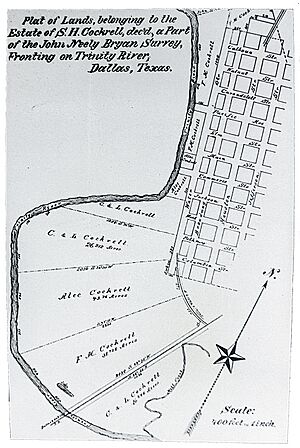History of Dallas (1856–1873) facts for kids
The story of Dallas, Texas, from 1856 to 1873 is about how the town grew from getting its official start to becoming a major hub when the railroads arrived.
Contents
Dallas Becomes a Town
On February 2, 1856, Dallas officially became a town. This meant it got a special document called a "town charter" from the Texas Legislature. This charter allowed Dallas to set up its own government.
The people of Dallas then elected their first leaders. Samuel Pryor became the first mayor. They also chose a Marshal (like a police chief), a treasurer-recorder (who handled money and records), and six aldermen (who were like town council members).
By 1859, Dallas was growing, adding its first barber shop and a photographer. By 1860, the town's population reached 678 people. This included 97 African Americans, as well as people from Belgium, France, Germany, and Switzerland. At this time, the railroad was getting closer to Dallas from the south, and many stage lines (like bus routes of the past) were already passing through the town.
The Great Fire of 1860
The year 1860 was a difficult time for Dallas, especially as the country was getting ready for the Civil War. People in Dallas had many public discussions about whether Texas should leave the United States (this was called secession). A group of volunteer soldiers also started training.
In July 1860, a big fire broke out in the town square. It destroyed most of the businesses in downtown Dallas. Many residents wrongly believed that enslaved people were responsible for the fire. Two people who were against slavery were forced to leave town. Luckily, most of the city was rebuilt by December of that same year. The population was growing so fast that it was often hard to find enough homes for everyone.
Dallas During the Civil War
In 1861, Dallas County voted to leave the United States, with 741 votes for secession and 237 against. On June 8, 1861, the state officially declared war. The citizens of Dallas strongly supported the war effort. The town was decorated, parades were held, and many people volunteered to fight.
Since Dallas was far from where most of the fighting happened, its citizens helped by giving money, flour, and other supplies to the Confederate army. A factory that made weapons was also built in the city. When the Union Army (the North) started to get close to Mississippi and Louisiana, the cotton that was usually sent to those states was instead shipped to Dallas.
Rebuilding After the War
The period after the Civil War, known as Reconstruction, brought new challenges and changes to Dallas. On June 19, 1865, a day now celebrated as Juneteenth, enslaved people in Texas were set free. Many African Americans moved to Dallas after the war. This was because Dallas was still doing well compared to many other cities in the Southern states.
New communities called Freedmen's towns were created around Dallas. Some white residents became worried by these changes. The Ku Klux Klan, a group known for its violence and racism, first appeared in Dallas in 1868.
Many Southerners who had lost money during the war came to Dallas to start over. They could no longer run large plantations, but the good farmland in North Texas offered new chances. Dallas kept growing during Reconstruction, unlike many other Southern towns that were still struggling to rebuild. By this time, Dallas had also become a major center for trading buffalo hides. In 1871, Dallas officially became a city, not just a town.
Politics during Reconstruction were often difficult. In the first elections after the war, only people who supported African American voting rights were allowed to register to vote. In 1872, Edmund J. Davis, who was the governor of Texas, tried to remove Henry Ervay, the mayor of Dallas, from his job. Mayor Ervay refused to leave and was put in jail. However, the state's highest court decided that the governor did not have the power to remove elected officials. So, Mayor Ervay was released.
The Railroads Arrive
In 1871, railroads were getting closer to Dallas. The leaders of Dallas did not want their city to be left out. They paid the Houston and Central Texas Railroad $5,000 to change its planned route. This made the railroad build its north-south tracks through Dallas, instead of through Corsicana, which was 20 miles (32 km) away.
A year later, Dallas leaders could not pay the Texas and Pacific Railway to come to their city. So, they found a clever way to make it happen. They added a special rule to a state law. This rule said that the railroad had to build its tracks through a place called Browder Springs. It turned out that Browder Springs was just south of Main Street in Dallas!
Because of these efforts, the two main Texas railroad routes, one going north-south and the other east-west, met in Dallas in 1873. This meeting point guaranteed that Dallas would become an important center for trade and business.
The arrival of the trains also caused the population to grow very quickly. Dallas's population jumped from 3,000 people in early 1872 to more than 7,000 by September of the same year. New buildings and businesses opened every day. Telegraph lines also came to Dallas, connecting it to the rest of the world.
Dallas became a central market for raw materials like grains and cotton, which were shipped to the south and east. It was also known as the "last chance" for people traveling west to get supplies before continuing their journey. Large, fancy hotels were built in the city. However, many other buildings remained simple and practical. Water and gas also became available. In 1871, the first volunteer fire company, Dallas Hook and Ladder Company #1, was formed to protect the growing city.


